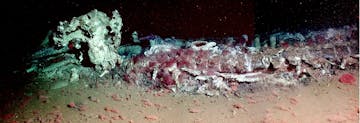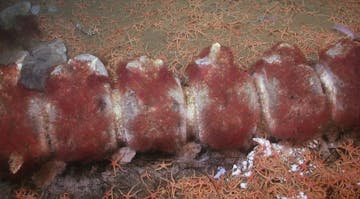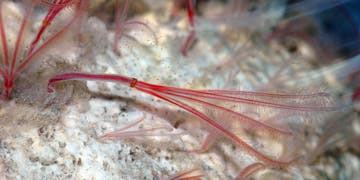Many fascinating findings and discoveries at MBARI have resulted from fortunate events of happenstance and serendipity. When Scientist Bob Vrijenhoek set out on a research cruise in Monterey Bay in 2002 in search of clams, he did not anticipate discovering a new genus of deep-sea worms that would greatly influence the next 15 years of his career.
On the day of the discovery, Vrijenhoek and other researchers aboard the R/V Western Flyer watched the video feed from the remotely operated vehicle Tiburon as it approached an area of seafloor that had elicited a large sonar signal, an area where they expected to find clams. Instead, they encountered a sunken gray whale carcass covered with a shaggy red carpet that turned out to be bizarre worms. The discovery has sparked the curiosity of researchers at MBARI and elsewhere and, in over a decade, has prompted many questions and unfolded a rich understanding of these remarkable worms.
Vrijenhoek, who joined MBARI in 1999, retired at the end of 2017. As he entered retirement, he made sure that all the samples and data his team had painstakingly collected about these worms were made available to the research community at large. His samples have been transferred to Scripps Institution of Oceanography and the Smithsonian Institution's Global Genomics Initiative, where researchers will have access to them for further study of these unique creatures and how they adapt to living in extreme conditions.

The worms are peculiar, to say the least. They have no eyes, legs, mouths, or stomachs, but they do have colorful plumes and bile-green roots that bore into the marrow cavity of bones of dead whales. One of their most fascinating features is the way they obtain sustenance. “When carcasses fall to the bottom of the ocean, there are no hyenas down there to eat the bones,” Vrijenhoek said. “What hyenas and condors do is crack open the bone to get the marrow. But there’s nothing at the bottom of the ocean that we know has that capacity.”
What the worms do is burrow their roots into bones and use symbiotic bacteria in their roots to extract fats and oils. They have developed a way of breaking down and processing nutrients from bones that had never been observed before.

Photo montage of the whale fall in Monterey Canyon that Bob Vrijenhoek and other MBARI researchers discovered during a 2002 dive using the remotely operated vehicle Tiburon. The red patches on the bones are thousands of deep-sea worms.
Within two days of the discovery, DNA sequences confirmed that the bone-eating worms were related to deep-sea tube worms found at hydrothermal vents and cold seeps. Vrijenhoek and Shana Goffredi (an MBARI postdoctoral fellow at the time, now an MBARI adjunct) sought an expert who could help identify the worms. They contacted Greg Rouse, then the curator at the South Australian Museum, who affirmed that the worms were entirely new to science. After taking a closer look, Rouse confirmed that the worms were annelids and relatives of deep-sea tube worms. Rouse worked with Vrijenhoek and Goffredi to classify the worms, creating a new genus called Osedax, which is Latin for “bone devourer.” In 2004, they published a paper in Science describing two new species, Osedax rubiplumus and Osedax frankpressi, both of which were observed on the gray whale carcass in 2002.

Curiously, all adult worms examined in the initial samples were females. What convinced Rouse that the worms were in fact annelids was the discovery of microscopic males, closely resembling typical worm larva and living as "harems" inside the gelatinous tube surrounding each adult female. These non-feeding males were full of yolk reserves that they used to produce bundles of sperm. The researchers subsequently learned that the first worm larvae to colonize bones developed into females that burrowed into the bones, and subsequent larvae that landed on females were transformed into males. As males accumulate, the "harems" can increase from several to hundreds of males per female, creating one of the most biased sex-ratios observed to date in the animal kingdom.
MBARI was in a unique position to pursue extensive research on Osedax worms. Following the discovery in 2002, several dead whales washed up along beaches in Monterey Bay between 2004 and 2008. Their carcasses presented opportunities for Vrijenhoek and his group to secure the dead whales, haul the carcasses offshore, and sink them at a variety of depths to see what animals would consume the flesh and colonize the bones. MBARI’s small size and its flexibility with ship schedules were major contributors to the success of these experiments. The beached whales washed up unpredictably, so the cooperation of other MBARI scientists who were willing to postpone their ship use for a few days was indispensable. Additional MBARI personnel were also important players in this endeavor: several marine technicians assembled weights to sink the carcasses, calculated how many weights were needed, and gathered up the required materials. “It wasn’t a trivial enterprise; it was complex,” Vrijenhoek said.
The MBARI team sunk whale carcasses at depths ranging from 385 to 1,820 meters; the locations varied in terms of pressure, temperature, and oxygen levels. The researchers revisited the carcasses, which had provided feasts for animals in an otherwise nutrient-poor environment, at various stages of decomposition. After sharks, crabs, and other large mobile scavengers stripped the carcasses of meat and tissue, various species of Osedax worms were observed on the remaining bones at all depths.

Osedax rubiplumus females populate the vertebral remains of a juvenile whale that MBARI researchers sunk at 1,800 meters depth in Monterey Bay in 2008. A dense population of brittle stars surround the bones on the seafloor.
Vrijenhoek had doubts early on that the worms consumed just whale bones. Initial molecular analyses of Osedax from Monterey Bay showed that their amount of genetic diversity was incredibly high. “It was no different from any nearshore polychaete worm that you would find along the California margin, which had population sizes in the millions,” said Vrijenhoek. “So why would something that had to live by finding dead whales on the bottom of the ocean maintain that massive genetic diversity, especially considering the scarcity of whale bones in modern times?”
The idea of the worms being specialized to whale bones was quickly put to rest. Vrijenhoek sought to explore other nutritional sources for Osedax, so his group assembled a smorgasbord of artificial carcasses out of cow bones, tuna bones, turtle bones, and turkey bones, and placed them on the seafloor at various depths. They found that the worms are capable of eating virtually any kind of bone on the seafloor. “Finding them on whale carcasses is more likely because they have greater residence time on the bottom of the ocean. They don’t get buried as quickly. They’re not going to be devoured as quickly, so your chances of finding them are good, whereas your chance of finding a tuna vertebra is not very good because those are going to disappear very rapidly,” said Vrijenhoek.
As an evolutionary biologist, Vrijenhoek was interested in the origin and evolutionary age of the worms. His team’s first guess was that early forms of Osedax arose coincidentally with large seagoing whales (somewhere between 45 and 30 million years ago) then diversified. This would make sense if the worms were specialized to whale bones; however, the experiments with artificial carcasses demonstrated that Osedax can eat many other kinds of bones. A plausible alternative was that Osedax arose during the Cretaceous Period (between 145 and 66 million years ago) and coincided with seagoing reptiles such as plesiosaurs. Then European researchers found fossil traces of Osedax in plesiosaur and sea turtle bones, validating the hypothesis that the worms originated during the Cretaceous Period, probably living on large marine reptiles and fishes.
Another unanticipated finding was the substantial role of Osedax worms in carbon cycling on the ocean floor. When large marine vertebrates die, they sink to the bottom of the ocean, where they can get buried by sediment or fall into a low-oxygen environment where their decomposition is slowed. The carcasses eventually become fossilized, their carbon effectively removed from the area. However, the carbon of whale carcasses, when devoured by Osedax worms and other animals, is immediately disseminated throughout the food web. Much of the carbon also ends up in nearby sediments. The mobile scavengers that feed on the whale tissue swim away, leaving behind their waste products that, in turn, enrich and fertilize the mud. This enrichment leads to the development of new bacterial communities in the sediment, another exciting area of research that has emerged from the discovery of Osedax. MBARI Adjuncts Victoria Orphan and Shana Goffredi will continue to study these fertilization events in ocean sediment and the associated bacterial communities.
The worms ignited the interest of many researchers outside of MBARI. Within a year of the original discovery in Monterey Bay in 2002, the worms were also seen on whale carcasses that researchers had intentionally sunk off the coasts of Sweden and Japan to see what would colonize the bones. To date, 18 species of Osedax have been identified at various depths in Monterey Bay, and 32 species have been observed worldwide.

Vrijenhoek and his group have also found two new species of marine snails that eat bones. These discoveries have shown how life can persist in a variety of places in a variety of ways. Finding new species that have adapted to surviving on bones so deep in the ocean is no longer a stretch of our imagination; these discoveries increase our understanding of what can exist on Earth, and opens our eyes to what may still be left to be discovered.
Vrijenhoek’s collection of Osedax samples has already been deposited with the Invertebrate Collection at Scripps Institution of Oceanography at the University of California, San Diego, where Greg Rouse is now a professor and curator. Invertebrate specimens have also been donated to the Santa Barbara Museum of Natural History and to the Smithsonian Institution’s Global Genome Initiative. Thus, the story of Osedax worms will continue to advance; there is plenty more to learn. “Most of science is like that,” said Vrijenhoek. “Every time you answer a question, you kick up 10 more perfectly good questions. This has taken on a life of its own. It’s just gone in so many different directions.”
